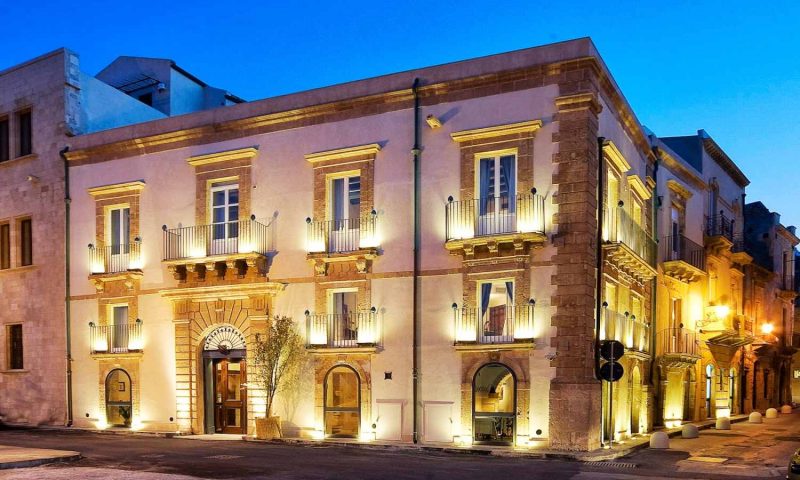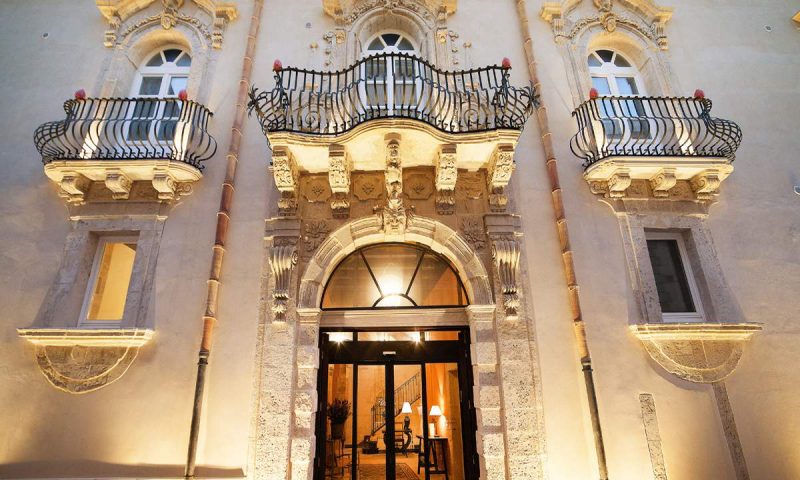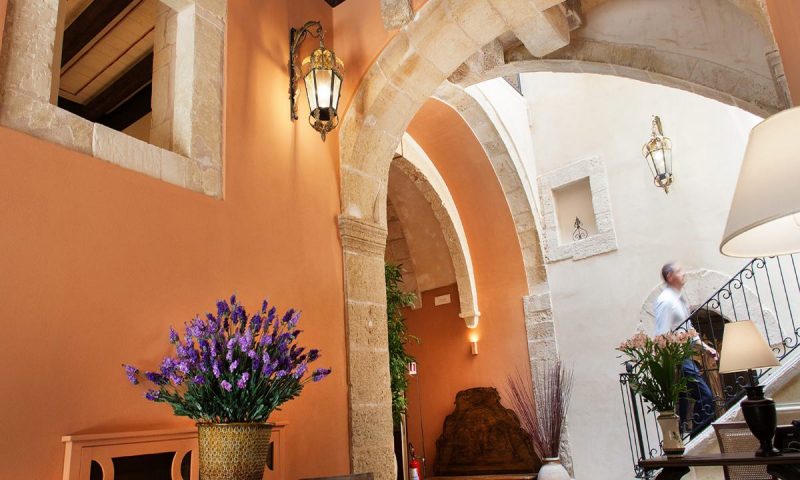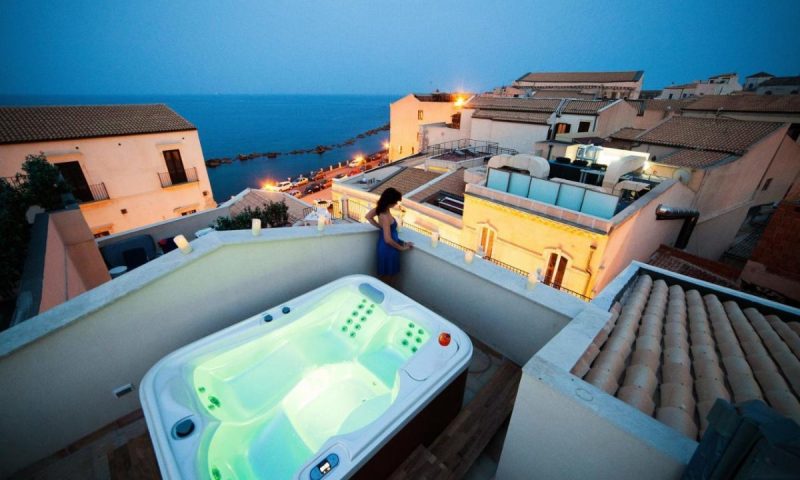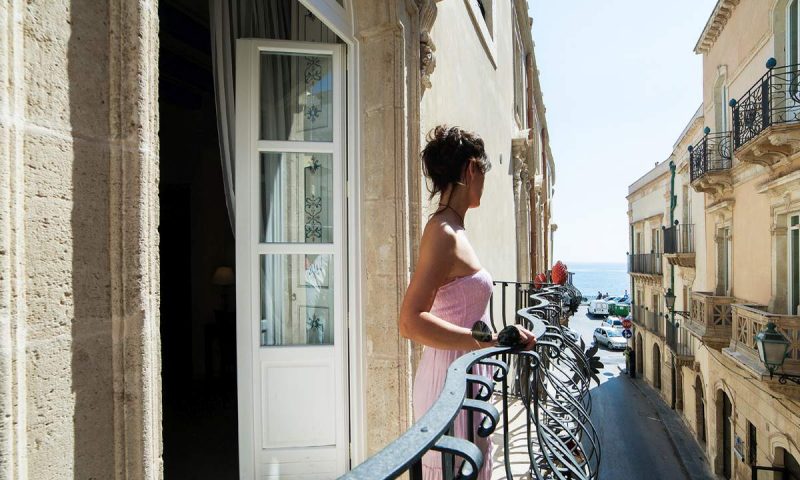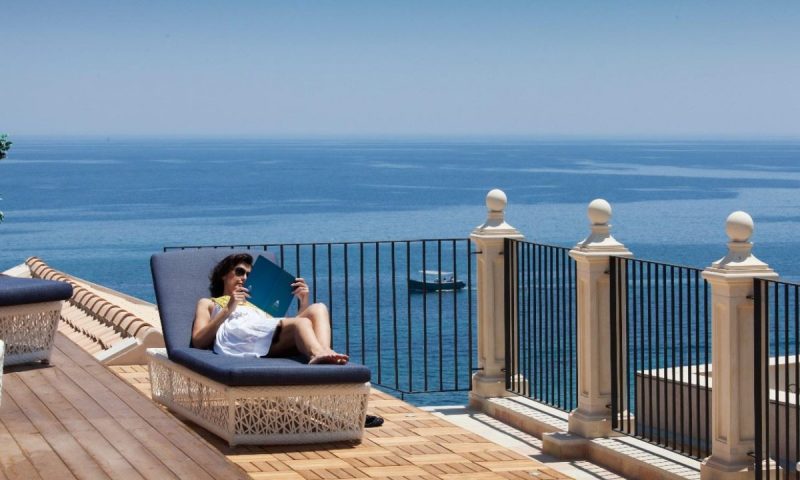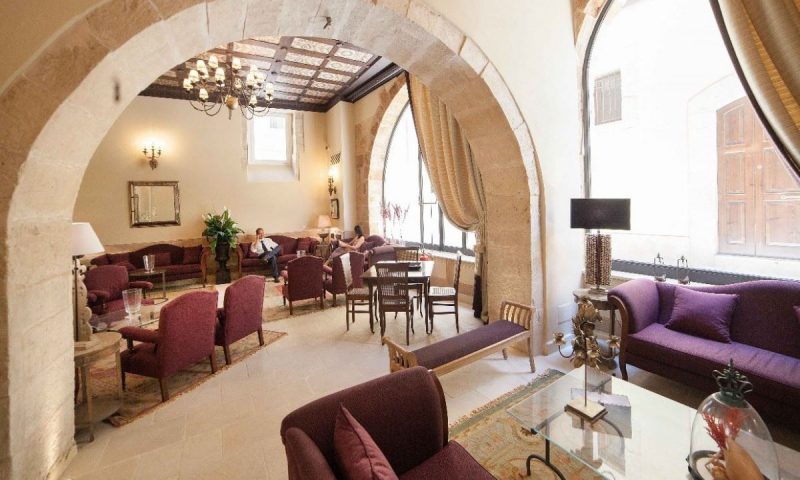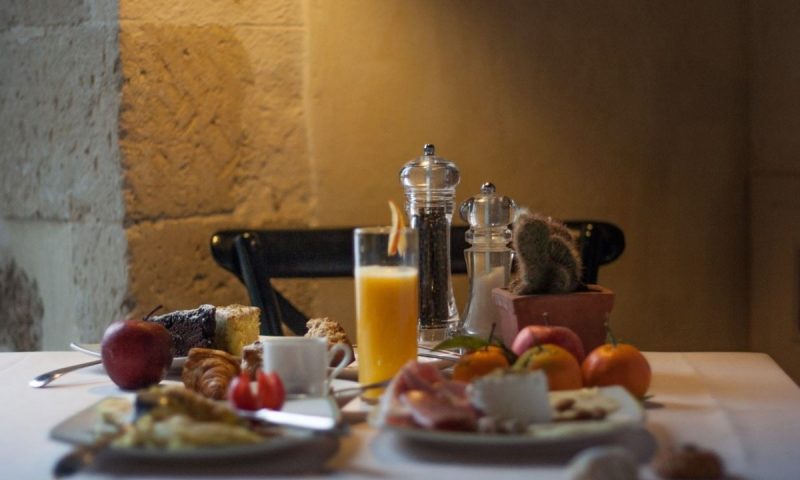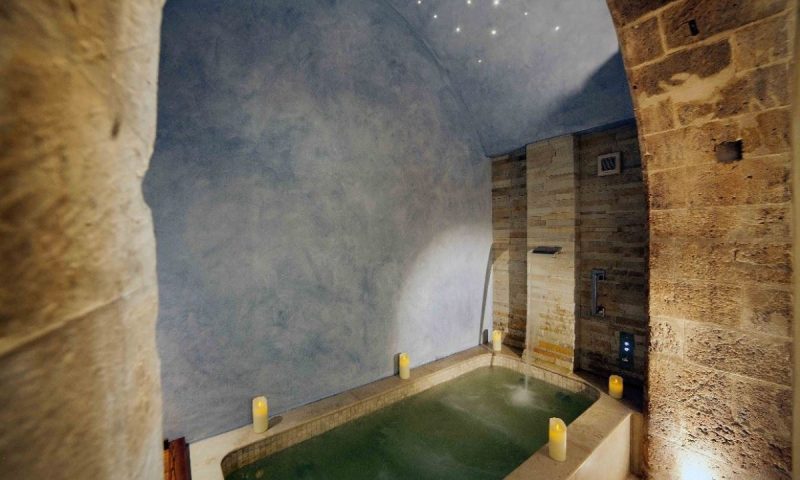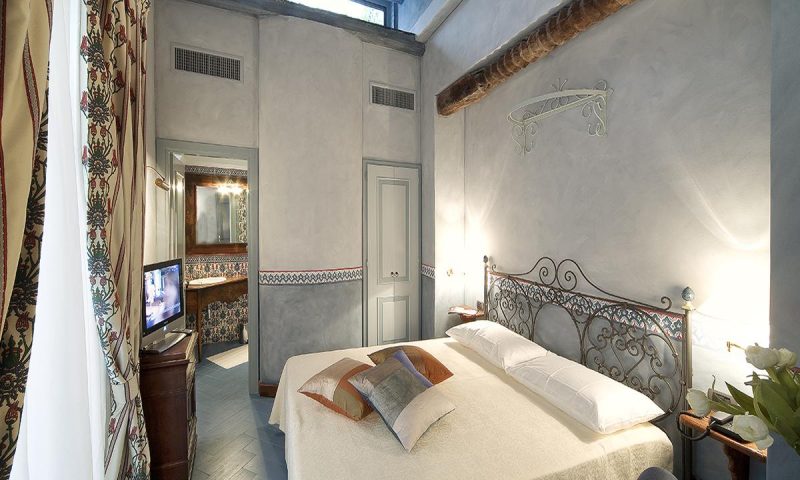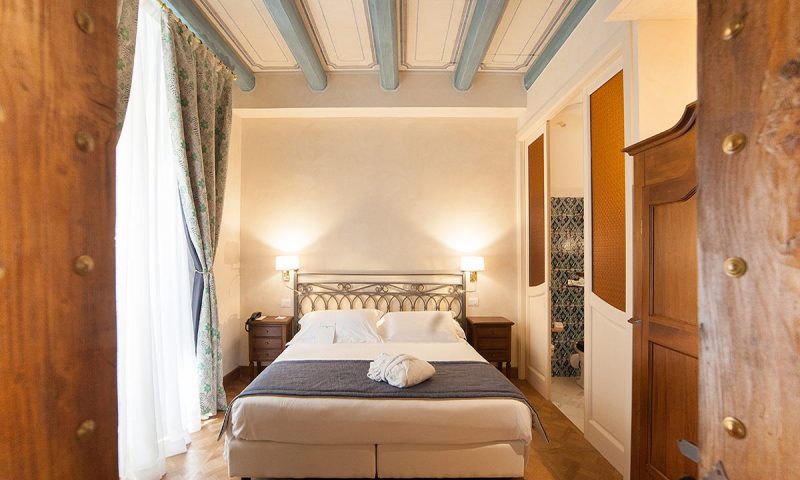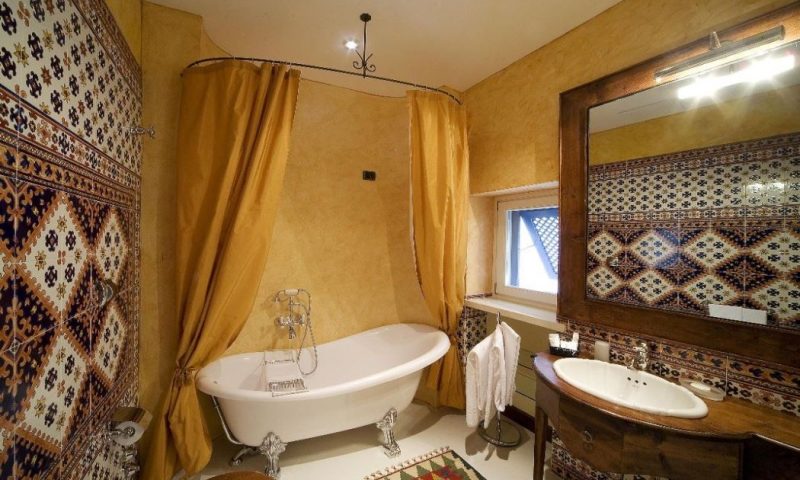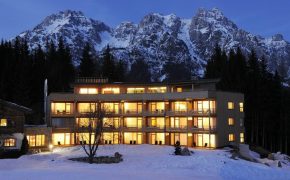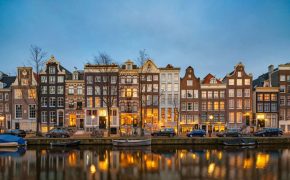Algilà Ortigia Charme Hotel stands on the ancient “Mastra Rua”, the location of the most important noble residences since the 14th century. The elegant palace that accommodates the hotel is the result of the fusion of two historic buildings, and the recent renovation works have preserved the original structures, contributing to the dynamic distribution of space.
The restoration was overseen by architect Manuel Giliberti who recovered the original stone features such as arches and carved keystones, complimenting them, when necessary, with new elements.
These additions were created with the same techniques and materials that have been used for millennia, including local limestone that significantly influenced the development of baroque style in the area.
Finally, decorations over old Sicilian designs revived what time had severely damaged, like the wooden ceiling of what is now the restaurant, which they were able to reproduce thanks to a few surviving panels. Sicily is a land where local craftsmen and artists preserve traditional methods by using centuries-old techniques.
Antique furniture, precious brightly-painted majolica tiles with ancient Sicilian designs, textiles in warm colours and an obsessive effort to hide modern technology to guarantee high-quality comfort, all produce a harmonious atmosphere that will play an important part in your Sicilian experience.
The rest will be taken care of by the Sicilians, with their great sense of hospitality, their culture, their natural courtesy and kindness that we hope you will experience yourselves, especially through the people who bring our hotel to life with great passion and commitment.
ROOMS
Every single one of our 54 rooms is unique and individually furnished with great attention to detail and the comfort of our guests. Every room has free wi-fi, as well as all the accessories and small luxuries of an elegant hotel.
You can also enjoy unlimited free phone calls and a complimentary minibar! What’s more, the hotel will gladly provide you with bicycles, free of charge, so you can comfortably explore Ortigia and the archaeological sites.
FAMILY SUITE
Ideal for a family holiday with two living areas and two bathrooms. Elegant and refined, with hand-painted exposed beams and furnished with antique details. Suitable for up to four adults and one baby in a cot.
DELUXE SPA
Romantic, comfortable and elegant with king-size beds. The refined decor and exposed beams create a unique environment. A large terrace with sea views overlooks the rooftops of Ortigia.
SUITE
Spacious and exclusive. Enjoy two elegant areas, one for daytime and one for night time. The furniture and sophisticated finishes create an atmosphere of refined luxury. From the balcony of some of the suites, it’s even possible to see the sea.
JUNIOR SUITE
Enjoy two elegant areas, one for daytime and one for night time. These rooms are overlooking a traditional Mediterranean courtyard. The bathrooms have large showers, some with chrome water jets. Suitable for up to three adults and a child in a cot (the third bed is in the living room).
DOUBLE WITH SEAVIEW
These rooms are characterised by antique Sicilian chests, woodwork and tiles decorated by hand. From the balcony, you can enjoy spectacular sea views.
THE RESTAURANT ALGILA’
A hidden gem between historic walls and modern sophistication. A dinner or a lunch at the restaurant Algilà is an authentic sensory experience, a cultural journey and a gastronomic adventure to the roots of the fascinating, rich and sometimes exotic culinary tradition of the island, reinvented with a modern and fresh twist by Chef Alessio Tito.
An appreciation for produce and the exaltation of flavour is the essence of a market cuisine that uses seasonal ingredients. The dishes are refined, but without frills.
With a nod to the splendour of aristocracy, they embrace the ingenuity of local cuisine made from humble ingredients which can’t be found elsewhere, like garden produce, the local fisherman’s catch or the traditional cheeses and cured meats.
Linguine with clams and Bronte pistachio pesto, fish arancini, beef in Nero D’Avola wine, seafood couscous and Mazara red prawns infused with Sicilian citruses are just some of the dishes from our seasonally changing menu, following the rhythm of nature, earth and the sea.
As for the sweets, chef Tito has a real passion for desserts and he will surprise you with his own unique interpretation of Sicily’s great classics.
MODERN KITCHEN, ELEGANT TRADITION
The bare stone archways, exposed beams and decorated coffered ceilings create a memorable ambience that reflects the essence of the restaurant. In this unique setting, the white napkins, the silver wear and the crystal glasses all enhance and contribute to the restaurant’s elegant and sophisticated personality.
THE ALGILA’ WINE CELLAR
Sommelier Sonia Sampognaro will guide you through the choices for the best pairings. The wine cellar of the restaurant boasts several local labels, as well as national ones, with some of the greatest Sicilian names side-by-side with excellent local producers ready to be discovered.
MEET THE CHEF
Alessio Tito, between instinct and training, tradition and innovation. Not yet 40, Alessio was born in Catania, but has been living in Syracuse for many years now. He is a young chef in love with his land and his job.
He graduated from the hospitality school Federico II di Svevia in Syracuse and while he was still studying he was already working in the kitchen of a local restaurant where he learnt the secrets of the traditional regional cuisine.
The high standard of his technical and academic training brought him into the kitchen of the restaurant Algilà as a sous chef in 2008 at just 22 years old. He perfected and adapted his cooking skills to a refined and international clientele and after only 3 years, he was promoted to head chef.
Since then Tito has skilfully guided the restaurant towards new horizons, keeping with the times while respecting the roots of a varied cuisine, firmly grounded in the culture of the area.
He is constantly reinventing himself, while staying true to his roots, partly thanks to the regular challenges he takes part in with other chefs on the battlefield of the Etoile Academy in Tuscany, near Viterbo, where he has participated in various masterclasses. Today Alessio Tito represents the embodiment of the spirit Algilà Ortigia Charme Hotel by way of his restaurant.
SYRACUSE: ART, HISTORY AND NATURE
At Algilà Ortigia Charme Hotel we are pleased to offer our guests an online guide to discover the cultural, historic and natural treasures of Syracuse and the surrounding area. Written by the renowned journalist and art expert Giovanni Dall’Orto, it was designed and written exclusively for us with our hotel as the starting point, in order to help you organise your excursions and enrich your stay with unforgettable experiences.
Syracuse experienced three distinct movements of exceptional development in art and culture. The first was the Greek era, when the city was a metropolis comprising hundreds of thousands of inhabitants and a fleet that sailed throughout the Mediterranean.
The second was the period of Gothic art and the Early Renaissance, when it was the capital of the Camera Reginale (“Queen’s Chamber”), a sort of personal fiefdom of the queens of the Kingdom of Sicily and Naples. The third was the Baroque period, when Syracuse had to be partially reconstructed after suffering damage from an earthquake in 1693.
Few recall that before the Roman conquest Syracuse was, for a long time, one of the grand metropolises of the Mediterranean and the only one able to fight the Carthaginians, to defeat the fleet of the Etruscans, or to engage in battle with the fleet of Athens, to the point of suffering – and repelling! – a double attack (in 433 and 416 B.C.).
One is perhaps misled by the memory of Syracuse as it returned to being after the fall of the Roman Empire: a city of a certain political and cultural weight but restricted once again to the island of Ortigia where it originated.
Instead, at the time of the “tyrants” (the somewhat flattering name by which the kings were called by their enemies), Syracuse had a footprint equal to that of today, as anyone traveling from Ortigia to the archeological area will notice.
Syracuse was the object of a careful plan of reconstruction and expansion (aided by the forced deportation of the populations from several defeated cities), evidence of which is still noticeable in many places.
Moreover, it says something that for the construction of the wall and fortifications, at a time of war against the Carthaginians for control over Sicily, Syracuse could mobilize as many as 60,000 men at a time and also manage to build ramparts in record time, thus thwarting enemy attack.
Its extraordinary power and wealth made the ancient city a point of international attraction for the most famous Greek intellectuals. Among the illustrious names that stayed in Syracuse we find: Plato, Pindar, Aeschylus, Simonides, Bacchylides, Sofrone, Epicharmus, and so on.
Being familiar with these circumstances allows one to more easily understand the splendor and size of Syracuse’s monuments from the Greek period. Even if they were, unfortunately, half demolished in modern times to recover their stones, what remains is enough to rank them among the most important and beautiful that the Greeks had left in Italy, thus rendering Syracuse worthy of a leisurely visit.
After the Arabic rule, the Christian re-conquest by the Normans left Syracuse competing in importance with Palermo. The Medieval period was certainly not “dark” for the city; on the contrary, Syracuse experienced a period of prosperity that left its mark on the plan of the city as well.
The Castello Maniace, built under the reign of the Swabian dynasty, and invoking elements of Gothic architecture still today is certainly the most renowned and best-preserved monument of this period.
Beyond this, it is worth noting how much remains of the Gothic buildings constructed during the period in which Syracuse had the rank of capital of the Camera Reginale (1302-1537), among them the Palazzo della Camera Reginale itself (located a few meters from Piazza Archimede).
The Camera Reginale constitutes a sort of “state within a state” and was formed from a fiefdom of a group of cities from which revenues were used for the personal patrimony of the ruler of the Kingdom of Sicily and Naples. It was a sort of endowment given to the bride by the groom himself and was passed down from queen consort to queen consort.
The presence of the Camera fostered the rebirth of a local political-bureaucratic class and left the city with an elegant Gothic imprint that bears the impression of local characteristics.
This aesthetic moment owes much to the Catalan Gothic (less bound by the presence of the pointed arch, less likely to feature soaring surfaces, much more sober, and favoring closed and smooth surfaces than those that characterize the international gothic style, especially “flaming”).
The relative decline caused by the suppression of the Camera Reginale would hold back further building, conserving the fundamental Gothic and Renaissance flavor of the city until an earthquake struck in the Baroque period.
The damage resulting from this natural disaster forced the rebuilding of a large part of Syracuse in the dominant style of the time. Despite this, several very elegant buildings that survived this and other earthquakes are scatters throughout the city and can be admired even today.
Among these are: the Palazzo Bellomo (seat of the Galleria Regionale), Palazzo Mergulese Montalto, Porta Marina, Palazzo Chiaramonte, the Maniace Castle, the church of San Martino, Palazzo Gargallo, and the church of San Pietro al Carmine.
The great earthquake of January 11, 1693 was judged to be the most devastating that Sicily had ever suffered in its history, if one excludes the 1908 Messina earthquake.
More than 45 villages were destroyed and approximately 60,000 deaths occurred. Several towns were literally razed to the ground, as was the case with the not-so-distant Noto.This city was reconstructed from the ground up, thus resulting in its moniker of the “Capital of the Baroque.”
Even though, in the case of Syracuse, complete reconstruction from scratch was not necessary, the rebuilding nevertheless resulted in a prevalently Baroque style with just a few surviving Gothic and Renaissance monuments.
The local limestone, which was easy to work with, allowed the stone cutters and the sculptors to indulge in those lacy stone balconies and façades that the buildings display in abundance.
The local Baroque style is lighter and less elaborate than that, equally known, of Lecce, and accordinggly leads to an airier result. The Syracusan Baroque , however, is no less fanciful: no two Baroque balconies are the same, and all compete in the pursuit of “invention” so dear to the Baroque style.
Given the sheer quantity, it is impossible to list all of the Baroque buildings of Syracuse. One is advised to follow on foot the principal streets of Ortigia (such as Via Vittorio Veneto – on which sits the Algilà Ortigia Charme Hotel – Via Maestranza, Via Giudecca…) to discover the thousands of surprises of Baroque Syracuse.
Following the explosive building period of the Baroque, the city would enter a period of economic and political stagnation until the unification of Italy. At this point in the nineteenth century, expansion began encroaching upon the borders of the Greek city and, in the end, overtook them. The courtyard of the Palazzo Bonanno – Syracuse: a beautiful example of the Syracusan Baroque.
Those who visited the island of Ortigia in the 1980s or 1990s will remember the abandoned condition in which they found it. The social changes in Italy after the war combined with emigration and the industrialization around Syracuse, brought progressive depopulation to the island.
Emptied of its inhabitants many of whom moved to new and more spacious houses on the mainland, and no longer undergoing maintenance, Ortigia literally began to fall to pieces.
Fortunately, after the mobilization of many people and associations who had fought a substantial battle to save its heritage, the island since proclaimed a World Heritage Site by UNESCO) was able to benefit from intervention and financing in the last 20 years.
This reinvestment triggered a beneficial wave of restoration and redevelopment that has literally changed the face of the city. While it is true that one can still notice while walking around Ortigia buildings that are crumbling (although still beautiful), by now a large part of the island has returned to its original splendor.
This phenomenon, however, unfortunately also had its disadvantages. The decision to save all of the island at once has, in fact, resulted in delays and difficulties. For many years visitors would therefore find some, if not most, of the monuments they had hoped to visit “closed for restoration”.
Fortunately, this phase is by now mostly over, and apart from a few drawbacks, most of the island and all its museums are now open to visitors again.
